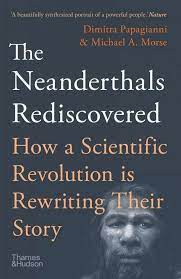The Neanderthals Rediscovered: How a Scientific Revolution is Rewriting Their Story
One
of my amateur interests is archaeology, and I find the Neanderthals
particularly interesting. Fortunately, most of what we know about our hominid
cousins has been found or studied fairly recently – mostly in the last ten
years. Last year I enjoyed Kindred:
Neanderthal Life, Love, Death and Art, 2020, by Rebecca Wragg Sykes (see my
post of February 24, 2022). But then at the end of the year I found a book that
was published earlier (2013, 2015 and updated in 2022): The Neanderthals Rediscovered: How a Scientific Revolution is Rewriting
Their Story by Dimitra Papagianni and Michael A. Morse (revised and updated
edition).
It’s
hard not to compare the two books, so I would have to say I enjoyed Kindred better. Somehow Wragg Sykes’s
writing was both more scientific and more enthusiastic about the subject. But
perhaps it’s because much of the information in The Neanderthals Rediscovered was not all new for me.
That
being said, it is a very interesting book, written in an accessible and casual
style, despite the scientific information. There are quite a few illustrations
and photographs, and a bibliography divided into sections for the general
reader; the specialist reader: books; the specialist reader: articles; and
fiction. Oddly, in this updated edition, they do not source Wragg Sykes’s book
or research, even though it’s more recent than their own.
The
structure of the book is from the historical background of the early discoveries
and research of the Neanderthals through to the last-known evidence of their existence
about 40,000 years ago. However, the final chapter is the weakest part of the
book and for me was dissonant with the first part.
From
the title of the final chapter, “Still With Us?,” I thought it would be about
the genetic research that proves that homo sapiens today have a small percent
of Neanderthal genes in their DNA, even though that was also covered in the
chapter, “An End to Isolation.”
However,
it was about the stereotypes of the Neanderthals as sluggish, club-carrying,
ape-like cavemen (we never hear about cavewomen!) that have been a part of
films, advertisements, illustrations, cartoons, and fiction (hence the “fiction”
section of the bibliography). This chapter is 27½ pages long, with example
illustrations. There is even a section about the names chosen for Neanderthals
in books and films. This seemed so out of place in a book about a “scientific
revolution.”
And
I also found the title at odds with the information in the book. Perhaps “rediscovered”
refers to the more recent information about the Neanderthals that reveals they
had an advanced tool culture, were not so different from us in appearance, and
had aspects of art and culture that were not known before. But I am still not
sure what the “Scientific Revolution” refers to. The scientific techniques and
type of research that has been used is not really new – certainly not new
enough to be considered a “revolution.” This is not made clear anywhere in the
book.
But this is probably too much nitpicking on my part. For readers who are interested in this subject and want to get a good overview of the latest information without too much technical detail, this is an excellent choice.


A very thoughtful response, thanks for sharing.
ReplyDeleteI appreciate your comment!
DeleteThis is a such an interesting topic. Thanks for talking about both books that you read on it.
ReplyDeleteI'm hopping in from the Nonfiction Reader Challenge.
Thank you for your comment - it's good to hear from another "Challenger"!
DeleteI find this topic interesting, mainly because 23 and Me says I am 2% Neanderthal.
ReplyDeleteMost of us who are not of African descent have some Neanderthal DNA. This has changed a lot of what we thought we knew about the Neanderthals and Homo Sapiens!
DeleteThis book sounds fascinating mainly because a DNA company told me I am 2.16% Neanderthal and my ancestors came from a specific cave in Belgium. Not sure how they figured that out.
ReplyDeleteIt would be interesting to learn how indeed they figured that out. Could be the basis for another book!
Delete